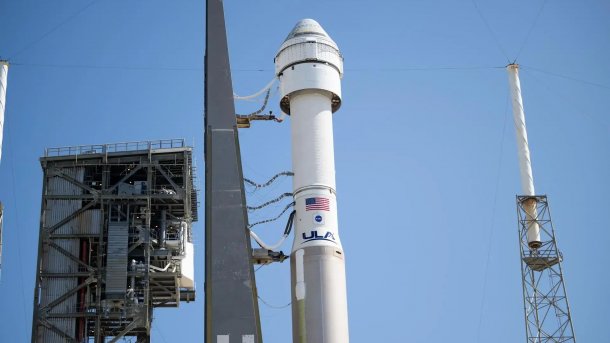NASA plans to launch Boeing's manned Starliner spacecraft in early June
After the helium leak, another problem was detected on the capsule. However, the risk is too low for NASA to postpone the Starliner launch any further.

Boeing Starliner on Saturn V rocket
(Image: NASA)
NASA and Boeing have set a new date for the first manned flight of the Starliner spacecraft. Now that the problems that led to the last delays have been investigated further and classified as minor, the Boeing capsule with two astronauts is to be launched into space on June 1, 2024 by an Atlas V rocket from the United Launch Alliance (ULA) and dock with the International Space Station (ISS) 24 hours later.
The helium leak, the reason for the last postponement of the Starliner launch in mid-May, still exists but, according to NASA, can be compensated for as it only occurred on one of the four propulsion rockets. It is therefore assumed that this is an isolated incident. If the situation does not deteriorate significantly, the capsule will be able to complete the mission without any problems.
Replacing the cap where the helium leak occurs would take months, as the capsule would have to be removed from the rocket and the toxic propellants pumped out before the cap (the size of a shirt button) could be replaced. The launch preparation process would then start all over again. As this does not pose a risk to flight safety, the flight can also be carried out with a helium leak.
New problem: design flaw in Boeing's rockets
During the investigations, however, a further problem was discovered in the propulsion system of the Starliner capsule. As a result, the first manned flight of the Boeing spacecraft, which had initially been postponed by just a few days, was canceled. The problem is a design flaw in Boeing's capsule rocket system. In a rare case, the various propulsion rockets might not be able to slow down the capsule appropriately on re-entry into the atmosphere.
Boeing has designed the Starliner's propulsion system as a combination of different rockets so that deceleration can be performed either with two of the four large rockets or with eight smaller maneuvering rockets, writes Ars Technica. If missiles placed next to each other were to fail, braking would not be possible. However, Boeing's engineers designed and successfully simulated a workaround within a few weeks, in which only four of the smaller rockets are used for braking.
Risk too low for further postponement
NASA puts the probability of the rockets failing on re-entry into the Earth's atmosphere at 0.77 percent. Steve Stich, manager of NASA's commercial crew programs, described this as a "pretty diabolical case". But why wasn't this determined in advance? Stich explained that it took a little more time to figure this out: "Maybe in a perfect time frame we could have detected this earlier."
Boeing and NASA are nevertheless going ahead with the next launch attempt. On Tuesday, the two astronauts will return to Florida for their final launch preparations and on Wednesday everything will be tested for the flight. If the go-ahead is given, the rocket with the Starliner capsule will be driven back to the launch pad on Thursday, May 30. The first possible launch window opens on June 1, but launches are also possible on June 2, 5 and 6 if the weather does not cooperate.
(fds)